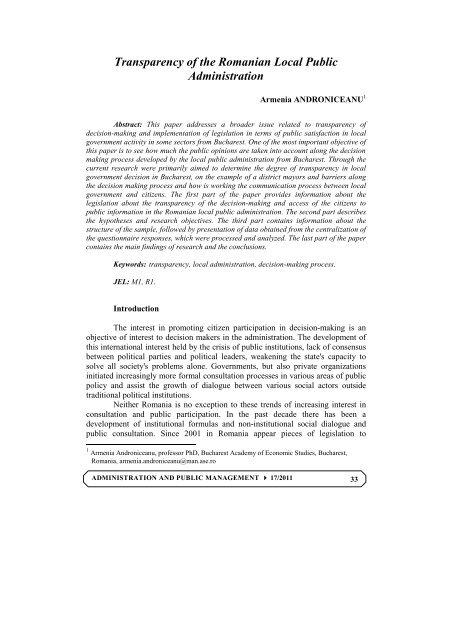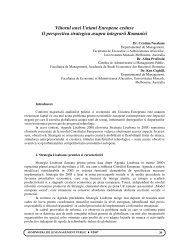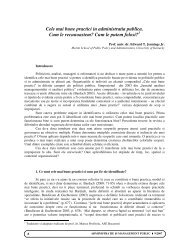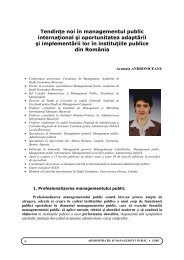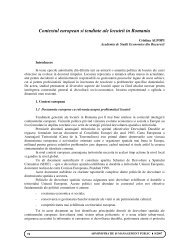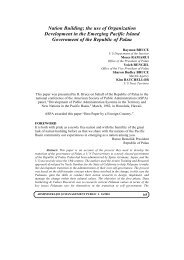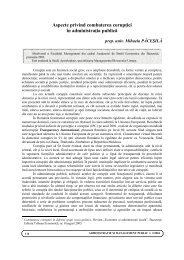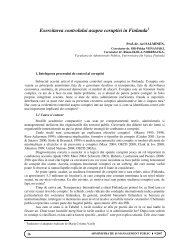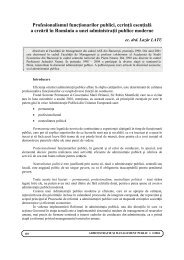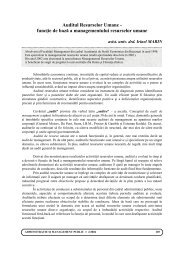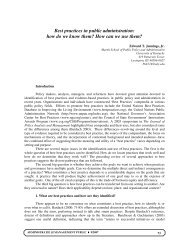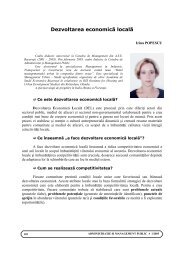Details - Revista Administratie si Management Public
Details - Revista Administratie si Management Public
Details - Revista Administratie si Management Public
You also want an ePaper? Increase the reach of your titles
YUMPU automatically turns print PDFs into web optimized ePapers that Google loves.
Transparency of the Romanian Local <strong>Public</strong> Administration<br />
Transparency of the Romanian Local <strong>Public</strong><br />
Administration<br />
Armenia ANDRONICEANU 1<br />
Abstract: This paper addresses a broader issue related to transparency of<br />
deci<strong>si</strong>on-making and implementation of legislation in terms of public satisfaction in local<br />
government activity in some sectors from Bucharest. One of the most important objective of<br />
this paper is to see how much the public opinions are taken into account along the deci<strong>si</strong>on<br />
making process developed by the local public administration from Bucharest. Through the<br />
current research were primarily aimed to determine the degree of transparency in local<br />
government deci<strong>si</strong>on in Bucharest, on the example of a district mayors and barriers along<br />
the deci<strong>si</strong>on making process and how is working the communication process between local<br />
government and citizens. The first part of the paper provides information about the<br />
legislation about the transparency of the deci<strong>si</strong>on-making and access of the citizens to<br />
public information in the Romanian local public administration. The second part describes<br />
the hypotheses and research objectives. The third part contains information about the<br />
structure of the sample, followed by presentation of data obtained from the centralization of<br />
the questionnaire responses, which were processed and analyzed. The last part of the paper<br />
contains the main findings of research and the conclu<strong>si</strong>ons.<br />
Keywords: transparency, local administration, deci<strong>si</strong>on-making process.<br />
JEL: M1, R1.<br />
Introduction<br />
The interest in promoting citizen participation in deci<strong>si</strong>on-making is an<br />
objective of interest to deci<strong>si</strong>on makers in the administration. The development of<br />
this international interest held by the cri<strong>si</strong>s of public institutions, lack of consensus<br />
between political parties and political leaders, weakening the state's capacity to<br />
solve all society's problems alone. Governments, but also private organizations<br />
initiated increa<strong>si</strong>ngly more formal consultation processes in various areas of public<br />
policy and as<strong>si</strong>st the growth of dialogue between various social actors out<strong>si</strong>de<br />
traditional political institutions.<br />
Neither Romania is no exception to these trends of increa<strong>si</strong>ng interest in<br />
consultation and public participation. In the past decade there has been a<br />
development of institutional formulas and non-institutional social dialogue and<br />
public consultation. Since 2001 in Romania appear pieces of legislation to<br />
1 Armenia Androniceanu, professor PhD, Bucharest Academy of Economic Studies, Bucharest,<br />
Romania, armenia.androniceanu@man.ase.ro<br />
ADMINISTRATION AND PUBLIC MANAGEMENT 17/2011<br />
33
Transparency of the Romanian Local <strong>Public</strong> Administration<br />
encourage public consultation. These elements are developed against the backdrop<br />
of the reform of governance and public administration reform, specific<br />
developments in the area of civil society. Specific legislative framework governing<br />
the transparency of public administration institutions is quite diver<strong>si</strong>fied.(Popescu,<br />
L.G., 2006) Some of the most important regulations related to transparency of the<br />
public institutions in Romania are:<br />
Law 52/2003 on deci<strong>si</strong>onal transparency in public administration;<br />
Law 544/2001 on free access to public information;<br />
GD 775/2005 for approving the regulation on procedures for drafting,<br />
monitoring and evaluation of public policies at central level.<br />
Consultation and public participation occur when citizens and public<br />
authorities have identified needs for consultation and participation and the<br />
mechanisms are de<strong>si</strong>gned to support the consultation or participation. OECD<br />
distinguishes three types of involvement of citizens in deci<strong>si</strong>on making:<br />
a. information - means that the deci<strong>si</strong>on making process is transparent<br />
enough for citizens to obtain information needed to see to what extent public<br />
authorities comply with their promises, to see what is happening in various sectors<br />
of public policy and to assess impact on them;<br />
b. consultation - allows citizens to provide feedback on policy options, in<br />
various stages of deci<strong>si</strong>on making. Generally, invitations to public consultation<br />
priority groups are addressed very well organized.<br />
c. Active participation - citizens become partners in making deci<strong>si</strong>ons.<br />
Citizens can propose public policy implementation strategies, participate in<br />
setting public policy objectives (Popescu, L.G., 2005). Transparency is important<br />
because the most number of normative acts issued in Romania are made by the<br />
executives at the local level (Colesca, 2010).<br />
According to the Romanian legislation, the transparency in local<br />
government means:<br />
a. ensuring citizens' access to public information;<br />
b. participation in the development of normative acts and public meetings.<br />
The public consultation procedure involves performing a minimum of<br />
work:<br />
<strong>Public</strong>ation of the draft regulatory;<br />
Announcement of intention to regulate;<br />
Discus<strong>si</strong>on documents in open court.<br />
As the Parliament of Romania stated, the law no. 52/2003 on deci<strong>si</strong>onal<br />
transparency in public administration was created in order to:<br />
enhance the accountability of government to the citizen, the beneficiary<br />
of the administrative deci<strong>si</strong>on<br />
increase the involvement of citizens in deci<strong>si</strong>on-making process of<br />
administrative and legislative drafting process<br />
enhance transparency across government.<br />
34<br />
ADMINISTRAŢIE ŞI MANAGEMENT PUBLIC 17/2011
Transparency of the Romanian Local <strong>Public</strong> Administration<br />
Ways in which public authorities (Ciocoiu, 2011) are obliged to provide<br />
public information about the work which they carry out are:<br />
a. display at the headquarters of the operating;<br />
b. publication in the Official;<br />
c. publishing in mass media;<br />
d. own publications;<br />
e. through their web<strong>si</strong>te;<br />
f. by providing opportunities for a local consultation.<br />
Scope of the Law no. 544/2001 has been extended by law no. 371/2006.<br />
(Burlacu, 2011) This resulted in inclu<strong>si</strong>on in the category of public institutions not<br />
only to ensure transparency of institutions and public authorities u<strong>si</strong>ng or<br />
administering public financial resources but also of the autonomous and national<br />
companies and companies subordinated to the central or local public authorities<br />
that Romanian state or territorial units (Popescu I.R. and Corbos, 2009).<br />
1. Research methodology, analisys and the main results<br />
There are some research hypothe<strong>si</strong>s con<strong>si</strong>dered from the very beginning<br />
like a starting points of this research<br />
in local government in Bucharest do not apply the law of transparency,<br />
as it is written and approved by the parliament;<br />
public institutions at local level in Bucharest don’t have resources<br />
necessary for a more transparent deci<strong>si</strong>on making process;<br />
There are other mechanisms at community level deci<strong>si</strong>on making, which<br />
leads to failure in all of law no. 52/2003.<br />
most people do not know the Law no. 52/2003 "on deci<strong>si</strong>onal transparency<br />
in public administration" and 544/2001 "on free access to public information."<br />
most people do not given importance to the above-mentioned laws.<br />
1.1 Objectives and the research stages<br />
The objectives of this research were to:<br />
identify the differences between legal provi<strong>si</strong>ons and how local<br />
authorities in Bucharest apply Law 52/2003 and 544/2001.<br />
identifying the barriers in law enforcement;<br />
identification of measures to increase transparency and communication<br />
in public administration;<br />
determining the degree of transparency in deci<strong>si</strong>on making within the<br />
community setting and barriers to involvement in deci<strong>si</strong>on making;<br />
evaluation of transparency changes initiated after EU acces<strong>si</strong>on.<br />
Exploratory research is an initial study with different levels of complexity,<br />
de<strong>si</strong>gned to clarify, define and identify the ba<strong>si</strong>c aspects of a problem or a<br />
marketing opportunity.<br />
ADMINISTRATION AND PUBLIC MANAGEMENT 17/2011<br />
35
Transparency of the Romanian Local <strong>Public</strong> Administration<br />
Investigation pos<strong>si</strong>ble qualitative models are:<br />
a) exploratory surveys among potential subjects, which are de<strong>si</strong>gned to<br />
obtain information about the services analyzed u<strong>si</strong>ng the tools of data collection<br />
surveys.<br />
b) the use of secondary data - is a method based on existing data stored in<br />
different forms. These data are usually in magazines, books, publications, etc.<br />
c) case studies - in-depth analy<strong>si</strong>s of one or more <strong>si</strong>tuations <strong>si</strong>milar to the<br />
problem under con<strong>si</strong>deration. It is a very useful method to learn from the<br />
experience of others, by adopting best practices.<br />
For questions contained in this questionnaire we used the following<br />
scales:<br />
Scale ratings, is a question con<strong>si</strong>sts of de<strong>si</strong>gning the questionnaire<br />
responses by listing several pos<strong>si</strong>ble response alternatives or the most important of<br />
these.<br />
Scale dichotomous nominal, allowing two alternative response indicating<br />
existence or lack of features, behavior, opinion, etc.<br />
Ordinal scales that allow hierarchy or ranking of alternatives or subjects<br />
studied according to certain criteria.<br />
1.2 Determining sample <strong>si</strong>ze<br />
The sample of this research study contains 30 people, all of them living in<br />
Bucharest for more the 20 years. The error (E) will be: E = 1.96 X 5.48 = 10.74<br />
Sampling unit is represented by an element or group of elements that can be<br />
selected to form the sample. We chose the sampling unit, the individual.<br />
The sample units to obtain information on which they draw conclu<strong>si</strong>ons<br />
valid for the entire population under con<strong>si</strong>deration. However, the sample is<br />
representative, because everyone has an equal chance of being included in the<br />
sample and because the error rate is not so high.<br />
The structure of respondents was:<br />
Age: from 18 to 25 years - 4 people, 26-35 years - 10 people, 2 persons<br />
- 36-45 years, 46-55 years-7 persons over 55 years - 7 people<br />
Education: high 23 persons, medium level – 7 persons<br />
Gender: 17 women, 13 men<br />
A permis<strong>si</strong>ble error limit of 3% would be better ensure representativeness.<br />
Reducing the sample to 30 people will have a representative sample error ±<br />
10.74% and a confidence level of 95%, which means an acceptable level of<br />
realism of the results.<br />
36<br />
ADMINISTRAŢIE ŞI MANAGEMENT PUBLIC 17/2011
Transparency of the Romanian Local <strong>Public</strong> Administration<br />
1.3 Research methods<br />
The questionnaire has a certain dynamic, a certain order of arrangement of<br />
questions.<br />
The order of arrangement of questions in the questionnaire is very<br />
important because it influences the subjects' deci<strong>si</strong>on to participate in the<br />
investigation and answer all questions. The questionnaire begins with <strong>si</strong>mple<br />
questions, general questions, questions that are then directly reach the issue of<br />
research and asking difficult questions intercalate more time thinking of questions<br />
ea<strong>si</strong>er.<br />
At the end of the questionnaire were placed questions characterization of<br />
subjects, enabling their description in relation to a number of criteria such as age,<br />
education level, occupation, income, gender. The questionnaire applied con<strong>si</strong>sted<br />
of a total of 17 questions. Users were asked to choose carefully con<strong>si</strong>dered choice<br />
closest to their point of view.<br />
This questionnaire contains questions both closed and open questions.<br />
There are differences between the shape and length of responses. Closed questions<br />
permit only fixed choice of answers before, with the pos<strong>si</strong>bility of quantification<br />
u<strong>si</strong>ng a scale responses. They have several advantages such as ea<strong>si</strong>er statistical<br />
analy<strong>si</strong>s supports the memory of the investigation, allowing the application of<br />
questionnaires with several items, increa<strong>si</strong>ng anonymity and safety of the<br />
investigation.<br />
The drawback of this type of question is that suggests an answer by<br />
presenting a sort of responses. Leaves open the questions of freedom of personal<br />
expres<strong>si</strong>on, bringing in extra people to know specifics. A disadvantage of this type<br />
of question is that are hard coded.<br />
3.4 Main findings<br />
This section of the paper is containing the questions and the main results<br />
obtained after the centralization of the answers provided by the citizens involved in<br />
this research.<br />
Question 1: How do you assess the relationship between citizens and the<br />
district city hall you belong The answers to this question is presented in Figure 1.<br />
Very good<br />
Good<br />
Bad<br />
Very bad<br />
Not answer (NS)/Not responding)<br />
Figure 1. The opinion of the citizens about their relation with the city hall<br />
ADMINISTRATION AND PUBLIC MANAGEMENT 17/2011<br />
37
Transparency of the Romanian Local <strong>Public</strong> Administration<br />
As can be seen approximately 56.66% of citizens believe they have a good<br />
relationship with city hall, while only 16.66% believe that the relationship with<br />
City Hall is poor and very poor, which shows some deficiencies in how a hall<br />
understands to work with citizens.<br />
Question 2: How do you work where you live in the District Municipality<br />
period from 2008 to present<br />
The answers of the subject to this question are presented in Figure 2.<br />
60<br />
50<br />
40<br />
30<br />
20<br />
10<br />
0<br />
Very good Bad No answ er -<br />
NS/Not<br />
responding<br />
- NR<br />
No of persons<br />
Figure 2. The assessment of the city hall activities after 2008<br />
As can be seen 60% of the industry people are satisfied with the work of<br />
the mayor in 2008-2011, which means a good level of recognition of the results<br />
obtained .<br />
Question 3: To what extent are you informed (a) initiatives and District<br />
Hall<br />
The answers to this question are presented in Table 1.<br />
Table 1. The degree of information about the city hall activities<br />
Largely<br />
In small<br />
extent<br />
In large<br />
extent<br />
In very<br />
small<br />
extent<br />
I don’t know/<br />
I don’t want to<br />
answer<br />
Total<br />
No of 3 4 15 3 5 30<br />
persons<br />
Percent 10% 13.33% 50% 10% 16,66 100<br />
As can be seen, approximately 50% of the citizens are informed about the<br />
initiatives and actions of the hall.<br />
Question 4: Do you know the laws no. 52/2003 and 544/2001<br />
As can be seen in Figure 3, the degree of knowledge by citizens of specific<br />
legislation on transparency is very low, most do not know the regulations.<br />
38<br />
ADMINISTRAŢIE ŞI MANAGEMENT PUBLIC 17/2011
Web page<br />
of the<br />
TV<br />
Information<br />
Centre<br />
Informative<br />
newsletter<br />
Transparency of the Romanian Local <strong>Public</strong> Administration<br />
Yes<br />
No<br />
Figure 3. The degree of knowledge of specific legislation<br />
As can be seen in Figure 3, approximately 60% of people in industry do<br />
not know the laws in deci<strong>si</strong>onal transparency and access to public information,<br />
which shows a weak interest both from the Mayor to inform citizens and of citizens<br />
to know their rights ari<strong>si</strong>ng out from their status of members of a community.<br />
Question 5: If your answer is yes, please assess on a scale from 1 to 10, the<br />
degree of implementation of these laws<br />
The answers are presented in Table 2.<br />
Table 2. The assessment of the legislation implementation degree<br />
1 2 3 4 5 6 7 8 9 10 Total<br />
No. 0 0 0 0 1 1 6 1 1 2 12<br />
Percent 0 0 0 0 8,33% 8,33% 50% 8,33% 8,33% 16,66% 100<br />
As can be seen in the table above, approximately 50% of those who know<br />
legislation about deci<strong>si</strong>onal transparency and access to public information. This<br />
percent is not enough as soon as we wanted to know how many of these regulations<br />
are implemented. It can be seen that most part of the citizens con<strong>si</strong>der that the<br />
legislation on transparency is not good implemented, even it exist for several years.<br />
Question 6: Where did you find most information about City bu<strong>si</strong>nesses<br />
On this question, subjects had different answers as we can see in Figure 4.<br />
50<br />
40<br />
30<br />
20<br />
10<br />
0<br />
No. Pers<br />
Figure 4. The sources of the citizens information<br />
ADMINISTRATION AND PUBLIC MANAGEMENT 17/2011<br />
39
Transparency of the Romanian Local <strong>Public</strong> Administration<br />
As we can see in the picture above, approximately 40% of those surveyed inform<br />
the work of the District Municipality of the City Newsletter that they receive even<br />
home addresses. But it can be seen as citizens acces<strong>si</strong>ng other information sources.<br />
Question 7: How often looking for information on the source specified above<br />
The answers to this question are found in Figure 5.<br />
40<br />
30<br />
20<br />
10<br />
No. Pers<br />
0<br />
Every few<br />
days<br />
Every day Weekly Monthly<br />
Figure 5. The frequency of acces<strong>si</strong>ng an information source<br />
As can be seen from the figure above, approximately 33.33% of the<br />
respondents are interested about city hall projects and they are informing about that<br />
every day u<strong>si</strong>ng different sources.<br />
Question 8: Are you satisfied (a) the manner in which the civil servants are<br />
facilitating the access to public information<br />
While citizens show a special interest in the activity hall sector in which<br />
they live, we can see in Figure 6 that they are quite unhappy that the city halls are<br />
offering less access to information then they are expecting for.<br />
Not at all<br />
Very satisfied<br />
50<br />
40<br />
30<br />
20<br />
10<br />
0<br />
Satisfied<br />
No. Pers<br />
In small measure<br />
Figure 6. The degree of satisfaction concerning the public information<br />
acces<strong>si</strong>bility<br />
40<br />
ADMINISTRAŢIE ŞI MANAGEMENT PUBLIC 17/2011
Web of the<br />
District Hall<br />
Internet<br />
<strong>Public</strong> Relation<br />
Office<br />
<strong>Public</strong><br />
Announcement<br />
s<br />
Telephone<br />
Transparency of the Romanian Local <strong>Public</strong> Administration<br />
As we see in figure above, approximately 46.66% of the respondents are not<br />
satisfied with how the employees of public institutions facilitate access to public<br />
information, which shows major deficiencies of the local authorities on their<br />
communication process and relationships with citizens.<br />
Question 9: Which of the options below you think are the best methods of<br />
communication<br />
The answers to this question are presented in Figure 7.<br />
50<br />
40<br />
30<br />
20<br />
10<br />
0<br />
No. Pers<br />
Figure 7. Preferred communication methods<br />
As we can see in the picture above, approximately 43.33% of the polled<br />
say the best method of communication is the Internet, while only 3.33% appreciate<br />
the phone as the best method of communication.<br />
Question 10: To what extent the information posted on the official<br />
channels of information are you think you help<br />
As we can see in Table 3, this question subjects appreciated the<br />
information provided is useful, at a rate of 30%, but are insufficient and 40%,<br />
which shows a series of limits on the mayor has the quality and usefulness of the<br />
information provided to citizens.<br />
Table 3. The utility of the public information<br />
Very useful Useful Irrelevant Insufficient Unnecessary Total<br />
No. 5 9 3 12 1 30<br />
Percent 16,66% 30% 10% 40% 3,33% 100<br />
As a result, approximately 40% of citizens con<strong>si</strong>der that the information<br />
sector posted on the official channels of information are insufficient, while only<br />
16.66% believe that this information are very useful.<br />
ADMINISTRATION AND PUBLIC MANAGEMENT 17/2011<br />
41
Transparency of the Romanian Local <strong>Public</strong> Administration<br />
Question 11: How often it happened that the municipality of the district<br />
officials create you difficulties in order to obtain public information<br />
In Figure 8 we see the opinion of citizens on their opinions concerning the<br />
acces<strong>si</strong>bility of public information. As can be seen, almost half of those surveyed<br />
con<strong>si</strong>der that they had some difficulty in obtaining necessary information, while the<br />
other half said that there were some difficulties in communication with the district<br />
city hall when they requested information or services.<br />
Not happened<br />
Quite often<br />
60<br />
40<br />
20<br />
0<br />
Often<br />
No. Pers<br />
Quite rarely<br />
Rarely<br />
Figure 8. The frequency of citizens difficulties along<br />
the communication process with the city hall<br />
As can be seen in the figure above, 50% of respondents have experienced<br />
difficulties in communicating with city hall officials when they asked for<br />
information or providing services.<br />
Question 12: In your opinion, in the following year, the degree of<br />
transparency in the deci<strong>si</strong>on will change<br />
Expressed in response to this question we can see that most subjects<br />
estimated the degree of transparency of the hall will remain the same in 60%. This<br />
percentage is added another 13.33%, which con<strong>si</strong>ders that transparency will<br />
decrease. This makes the percentage to rise to 73% in real terms which is a<br />
negative <strong>si</strong>tuation. As can be seen in Table 4, to this figure is added at a rate of<br />
26.66 people % which show that the people don’t know or they don’t think that<br />
something will be changed in terms of transparency of public institutions in the<br />
future.<br />
Table 4. The evolution of the city hall’s transparency degree<br />
Will Will Will remain the I don’t know Total<br />
increase decrease same<br />
No. 1 4 18 8 30<br />
Percent 3,33% 13,33% 60% 26,66% 100%<br />
Question 13: In your opinion, after joining the European Union deci<strong>si</strong>onmaking<br />
level of transparency District Municipality has changed<br />
42<br />
ADMINISTRAŢIE ŞI MANAGEMENT PUBLIC 17/2011
Urban<br />
infrastructur<br />
e<br />
Social<br />
services<br />
Economic<br />
environment<br />
Turism<br />
Transparency of the Romanian Local <strong>Public</strong> Administration<br />
Figure no. 9 is showing us the fact that no <strong>si</strong>gnificant changes occurred in<br />
terms of deci<strong>si</strong>onal transparency, after Romania's EU acces<strong>si</strong>on. That means that<br />
they don’t feel any <strong>si</strong>gnificant changes related to the transparency of the public<br />
institutions after the Romanian integration into the European Union.<br />
Remained the same<br />
Decreased<br />
No. Pers<br />
Increased very little<br />
Increased<br />
0 5 10 15 20 25 30 35 40 45<br />
Figure 9. The institutional transparency degree after the Romania integration<br />
in the EU<br />
Only 23.33% of the respondents con<strong>si</strong>der that the degree of transparency in<br />
the deci<strong>si</strong>on of the District Municipality increased after Romania's EU integration,<br />
which is a very low level and is showing us not too much progress in the issue.<br />
Question 14: City District is currently developing a new strategy for development<br />
from 2011 to 2020. What do you think is the priority sector development<br />
As can be seen in Figure 10, the most citizens do not know exactly which<br />
are the priority areas of the city hall. It explains their diveri<strong>si</strong>fied answers. It also<br />
means a lack of communication and an unclear vi<strong>si</strong>on of the local public<br />
administration concerning their priorities.<br />
35<br />
30<br />
25<br />
20<br />
15<br />
10<br />
5<br />
0<br />
No. pers<br />
Figure 10. The citizens view concerning the strategic priorities of the city hall<br />
Question 15: Please state the biggest advantage of the sector that can<br />
contribute to the development of it:<br />
The answers to this question are represented in Figure 11. It can be seen<br />
that more than half of the subjects appreciate the existence of green space as a big<br />
advantage of the sector in which they live, because diver<strong>si</strong>fy their opportunities for<br />
recreation and relaxation.<br />
ADMINISTRATION AND PUBLIC MANAGEMENT 17/2011<br />
43
Transparency of the Romanian Local <strong>Public</strong> Administration<br />
70<br />
60<br />
50<br />
40<br />
30<br />
20<br />
10<br />
0<br />
Green spaces Comercial Markets Agricultural markets<br />
No. pers<br />
Figure 11. The main advantages of the district<br />
As can be seen, approximately 60% of people who responded to this<br />
survey, believes that the sector's biggest advantage is the existence of green areas,<br />
many of them arranged in recent years. But they also appreciated the fact that they<br />
have diver<strong>si</strong>fied markets.<br />
Question 16: Please specify the largest disadvantage of the sector, which<br />
may contribute to the development sector.<br />
As can be seen in Table 5, in the opinion of the subjects, the greatest<br />
disadvantage of the sector in which they live is that not enough parking spaces<br />
(40%) and about 33.3% are con<strong>si</strong>dering that the district has a very poor road<br />
infrastructure.<br />
Table 5. The main disadvantages of the district<br />
Lack of Insufficient Bad local<br />
Total<br />
parking spaces kindergartens infrastructure<br />
No 12 8 10 30<br />
Percent 40% 26,66% 33,33% 100%<br />
Question 17: Please specify the largest threat to the sector, which may<br />
prevent development of:<br />
On this question, the answers subjects are presented in Figure 12. As can<br />
be seen, in the opinion of citizens the main threat is on the small number of places<br />
for children in kindergarten, because the number of public kindergartens is<br />
reduced. The second major threat is on projects that make it difficult for citizens to<br />
travel from certain areas of Bucharest to the others.<br />
Road infrastructure<br />
Insufficient places in the<br />
kindergardens<br />
Figure 12. The main threats of the district<br />
44<br />
ADMINISTRAŢIE ŞI MANAGEMENT PUBLIC 17/2011
Transparency of the Romanian Local <strong>Public</strong> Administration<br />
When asked which refers to serious problems of the sector, respondents<br />
were very different opinions, as can be seen in Table 6.<br />
Table 6. Assessment of the severity of problems<br />
No. Percent<br />
The quality of the health services 0 0%<br />
<strong>Public</strong> order and peace 0 0%<br />
Need of houses 4 13,33%<br />
Cleaning the streets 1 3,33%<br />
Services of the citizens by the civil servants 1 3,33%<br />
State of the agricultural markets 5 16,66%<br />
Maintenance of schools, kindergartens and high schools 2 6,66%<br />
Quality of the local transport 1 3,33%<br />
Population of the environment 2 6,66%<br />
Acces<strong>si</strong>bility of the citizens to the health services 5 16,66%<br />
Places for cars parking 8 26,66%<br />
Street lighting 1 3,33%<br />
Other problem 0 0%<br />
I don’t know/I don’t want to answer 0 0%<br />
Total 30 100%<br />
Conclu<strong>si</strong>ons<br />
One of the important findings of this research is that the Law no. 544/2001<br />
of free access to public information and that the law no. 52/2003 on deci<strong>si</strong>onal<br />
transparency demonstrates that the implementation of themby the local public<br />
administration in Bucharest is very problematic. Although exposed during work<br />
practice analy<strong>si</strong>s confirms, in an argument that transparency and citizen<br />
participation in the deci<strong>si</strong>on-making are two essential prerequi<strong>si</strong>tes for increa<strong>si</strong>ng<br />
the quality of local governance, yet there are serious problems on the application,<br />
meaning that they, for various reasons fail to find its full implementation.<br />
As a result of research, law no. 52/2003 transparency of deci<strong>si</strong>on is known<br />
and used almost exclu<strong>si</strong>vely by non-governmental organizations, but problems<br />
remain to be addressed for such a law as fundamental to improving the quality of<br />
local governance, to achieve the purpose for which it was initiated and adopted.<br />
This is because the number of people who use this law for the recovery of two<br />
fundamental rights are enshrined in the Constitution is still quite small. According<br />
to research, the reasons are many, some even taking the mentality of citizens and<br />
their lack of experience and democratic practice.<br />
The research pointed out the fact that if local authorities in Bucharest in<br />
general and in particular want government to be a bureaucratic, formalistic and<br />
ADMINISTRATION AND PUBLIC MANAGEMENT 17/2011<br />
45
Transparency of the Romanian Local <strong>Public</strong> Administration<br />
much less effective, they must develop mechanisms to allocate resources and to<br />
encourage citizens to know and to con<strong>si</strong>der their claims.<br />
In principle, the transparency of deci<strong>si</strong>on-making is very well described by<br />
the Romanian legislation, but the local public administration is not very well<br />
prepared to deal with. Even the civil servants are very reluctant many times in<br />
offering the free access to the public information. Law no. 52/2003 is a general<br />
legal framework in relation to the requirement of insurance covering the legislative<br />
framework and institutional practice required the active participation of citizens in<br />
local government deci<strong>si</strong>ons, as reflected in the existing national regulations in some<br />
EU countries and in United States of America.<br />
Citizens take part in the activities initiated by the local authority if they<br />
understand the essence of the problem and what is expected of them. Then they<br />
come up with initiatives, ideas and proposals that are sometimes unexpected, useful<br />
and practical, even for profes<strong>si</strong>onals from the local authority. That means that the<br />
local authorities should increase the cooperation with the citizens and the actors of<br />
the local bu<strong>si</strong>ness environment in the near future in order to be more effective in<br />
their work.<br />
References<br />
1. BURLACU, S. (2011). “Characteristics of knowledge-based economy and new<br />
technologies in education”, Administration and <strong>Public</strong> <strong>Management</strong> Review, Issue 16,<br />
pp. 36-41.<br />
2. CIOCOIU, N.C., (2011). “Integrating digital economy and green economy:<br />
opportunities for sustainable development”, Theoretical and Empirical Researches in<br />
Urban <strong>Management</strong>, vol. 6, issue no.1, pp. 33-43.<br />
3. COLESCA, S. (2010). “Online consumer. Theories of human relativism”, Amfiteatrul<br />
Economic Journal, Volume 12, Issue 28, pp.694-699.<br />
4. PLUMB, I.; ANDRONICEANU, A.; ABĂLUŢĂ, O., (2003), <strong>Management</strong> of the<br />
public services, Bucharest Academy of Economic Studies Publishing, Bucharest, pp.<br />
138-267.<br />
5. POPESCU I.R.; CORBOS, R. (2009). ’’The Role of Urban Brand Measuring Tools<br />
in Grounding the Strategic Actions for Promoting Cities’’, Administration and <strong>Public</strong><br />
<strong>Management</strong> Review, issue no. 13, pp. 116-142.<br />
6. POPESCU, L.G. (2007). Comunicare în administraţia publică, Editura Economică,<br />
Bucharest; pp. 110-115.<br />
7. POPESCU, L.G., (2006), <strong>Administratie</strong> şi Politici <strong>Public</strong>e, Economică Publishing,<br />
Bucharest, pp.115-178.<br />
46<br />
ADMINISTRAŢIE ŞI MANAGEMENT PUBLIC 17/2011


